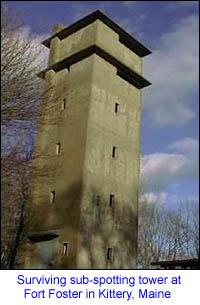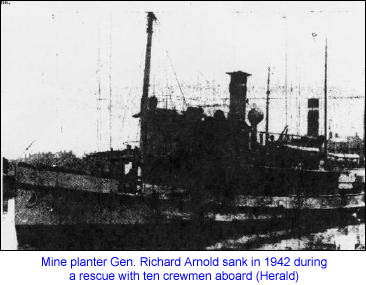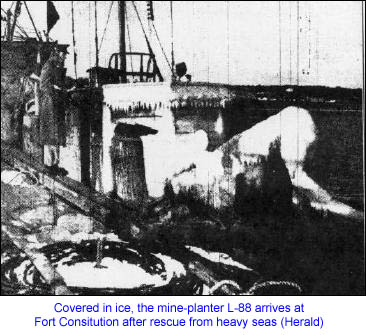| Mine Planter Richard Arnold Sinks |

WW2 MARITIME HERITAGE
January 1942
During the 20th century deadly mines were planted along the floor of the Piscataqua connecting NH and Maine. Although none were detonated, ten men died when a mine-planter sank off the Isles of Shoals. This is the story of the Richard Arnold by reader request.
JUMP to newspaper account
One little-known fact about WW2 is that the Army had more ships that the Navy! A reader recently asked us about the sinking of a mine-planter shipping off the Isles of Shoals in January 1942. We had not heard the story. Historian Richard Winslow located the report in the Portsmouth Herald archives and it is reprinted below.
The Sinking of the Gen. Richard Arnold
 Ten crewmen died when the ancient ship GENERAL RICHARD ARNOLD, built in 1909, sprang a leak in a storm. The ARNOLD sank after successfully saving another Army mine-planter that had suffered engine trouble while heading to Portsmouth. Originally eight crewmembers, mostly civilians, were reported lost. The next day that number was increased to ten. Only the commander survived when he jumped into the water and was rescued. Witnesses later reported that the captain had bravely called to rescuers, "Never mind me. Save the others!" as he floundered in the icy waters.
Ten crewmen died when the ancient ship GENERAL RICHARD ARNOLD, built in 1909, sprang a leak in a storm. The ARNOLD sank after successfully saving another Army mine-planter that had suffered engine trouble while heading to Portsmouth. Originally eight crewmembers, mostly civilians, were reported lost. The next day that number was increased to ten. Only the commander survived when he jumped into the water and was rescued. Witnesses later reported that the captain had bravely called to rescuers, "Never mind me. Save the others!" as he floundered in the icy waters.
Little known and rarely honored, Army ships mined key American harbors including Portsmouth, New Hampshire during wartime as part of an elaborate coastal defense network. Remnants of the WW2 era forts survive in New Castle and Rye and Kittery. Visitors can still see them at Fort Stark, and Fort Foster from which mines were strung below the Piscataqua, ready to be triggered electronically. None were ever activated.
Mines were set off, not by contact with the enemy ship, but by wired systems set off by observers in the watchtowers. Although none of the mines were ever deployed, a number of the coastal defense observation towers still stand along the Seacoast. Small mine-planters, some pre-dating the First World War were used to lay the cables and junction boxes that would set off the mines. The junior mine-planter Gen. Richard Arnold was apparently named for a Civil War Union brigadier general (1828-1882)
Lester Stevens, now living in Rye, NH, was assigned to the ARNOLD on the day of the disaster, but told the local newspaper recently that he was kept back to perform KP duties. He learned hours later that his entire crew had perished in the rescue attempt in 20-foot waves. Their bodies were never recovered. – J D Robinson
EXTERNAL LINK
For more on Coastal Defense Systems
PortsmouthForts.com
Continue with MINE-PLANTER TRAGEDY
1942 ACCIDENT OFF ISLES OF SHOALS

Sinking of the Richard Arnold
Portsmouth Herald
Tuesday Evening
January 8, 1942
Army Mine Planter Sinks
in Storm off the Shoals
Eight Crew Men Drowned
Portsmouth Herald
Tuesday EveningJanuary 8, 1942
Ft. Constitution Boat is Lost While Assisting Sister Craft
Commander is Only Man Saved in Ocean Mishap
Eight men drowned during a heavy storm early this morning about 20 miles Southeast of the Isles of Shoals. (Note: Later amended to ten men lost.)
Only one man of the crew of nine on the 98-foot Army mine-planter General Richard Arnold was saved when the 33-year old ship suddenly sprang a leak and went to the bottom.
Eight men drowned during a heavy storm early this morning about 20 miles Southeast of the Isles of Shoals. Only one man of the crew of nine on the 98-foot Army mine-planter General Richard Arnold was saved when the 33-year old ship suddenly sprang a leak and went to the bottom.
Saved was William H. Chasteen of Waterford, Conn., commanding the Arnold, who jumped from the bridge as the ship went under and was picked up by another disabled mine-planter the L-88.
Army officials at the Portsmouth Harbor Defenses said that names of the eight lost would not be given out until Master Chasteen arrived in New Castle on the L-88 to check the list and determine definitely who was on board, as the Arnold had two shifts of its crews.
The crew of the Arnold lost their lives whole attempting to rescue the nine man crew of the L-88 which was disabled and had been drifting in the storm for more than six hours.
Coast guard and army planes and boats today searched the area but only empty lifeboats and life-belts marked the spot where the Arnold had sunk. No bodies had been recovered after nine hours search.
Meanwhile the army mine-planter Absolom Baird which had rushed to the scene and was assisting in towing the disabled L-88 assisted in the search and then started back to its dock at New Castle with the L-88 in tow.
Army officials said this morning the Baird was 30 miles out at 10 am and making slow headway against heavy seas. It was not expected in until late this afternoon.
Story of the sinking, drownings and the rescue in the bitter cold of the storm tossed Atlantic revealed the heroism of the army afloat in an epic that would do credit to the navy.
Continue with MINE-PLANTER TRAGEDY
1942 ACCIDENT OFF ISLES OF SHOALS

Has Engine Trouble
Shortly after noon yesterday the L-88 which was coming up the coast radioed that it had engine trouble and needed assistance. Its position was given about 14 miles southeast of White Island off Cape Ann, Gloucester.
Army officials immediately sent out the General Arnold to assist it and the navy tug Yaquima was ordered out. Just outside Portsmouth harbor the ships began to buck heavy seas and take on water which immediately iced up. So serious was the icing that the Yaquima was ordered back but the little top-heavy Arnold continued on, and the mine-planter Absolom Baird was ordered out.
Meanwhile army officials at the Portsmouth Harbor Defenses had gotten in touch with the air base at Manchester and an army plane was sent in search and a coast guard plane from Salem was ordered out. Toward dark, the army plane located the L-88 and dropped a flare directly astern of it.
Using this for a bearing the little Arnold ploughed on and reached the L-88 where lines were put aboard and the two ships side by side started toward Portsmouth about 8:30 pm, Little progress could be made because of the heavy seas.
The Baird, under command of Major M.A. McLamb reached the scene several hours later and took the two ships in tow.
Ice Formed Rapidly
It was bitter cold and a sharp offshore wind drove waves and spray over the two Vessels where it froze at once. A snow squall filled the air with swirling flakes hardly discernable in the pitch dark.
At 12:50 am, Master Chasteen reported the Arnold was taking water by the stern, and men were manning the pumps. But the water continued to rise and 40 minutes later it was over the pumps and fires. At 1:45 the Arnold suddenly plunged to the bottom.
Only quick action of the crew of the L-88 saved that ship from being dragged to the bottom by the Arnold. The Quartermaster’s civilian crews which man these boats risked their lives on icy wind and wave swept decks to cut the lines.
Master Chasteen high on the bridge of the Arnold jumped clear just as the ship went under. Quick action by the skipper of the L-88 who kept his little ship dangerously close to the suction of the foundering Arnold, enabled his crew to rescue Chasteen. Coastguard cutters and navy ships were ordered to the scene where empty life boats and life belts were the only surviving signs.
The L-88 was en route to Portsmouth when the engine trouble developed. When it was found that the little ship was drifting rapidly out to sea, the ensign was hoisted up side down in the conventional distress signal and a distress message sent to the Portsmouth Harbor Defenses.
The 179-ton Arnold had at first planned to tow the L-88, but at 8:30pm, when the Arnold picked up the L-88 the weather was so rough that it tied up along side and used its engines to keep the L-88 drifting until the Baird arrived about midnight and took both in tow.
Portsmouth HeraldTuesday EveningJanuary 8, 1942 Eight men drowned during a heavy storm early this morning about 20 miles Southeast of the Isles of Shoals. Only one man of the crew of nine on the 98-foot Army mine-planter General Richard Arnold was saved when the 33-year old ship suddenly sprang a leak and went to the bottom. Portsmouth HeraldTuesday EveningJanuary 8, 1942 Eight men drowned during a heavy storm early this morning about 20 miles Southeast of the Isles of Shoals. Only one man of the crew of nine on the 98-foot Army mine-planter General Richard Arnold was saved when the 33-year old ship suddenly sprang a leak and went to the bottom. Portsmouth HeraldTuesday EveningJanuary 8, 1942Eight men drowned during a heavy storm early this morning about 20 miles Southeast of the Isles of Shoals. Only one man of the crew of nine on the 98-foot Army mine-planter General Richard Arnold was saved when the 33-year old ship suddenly sprang a leak and went to the bottom.
